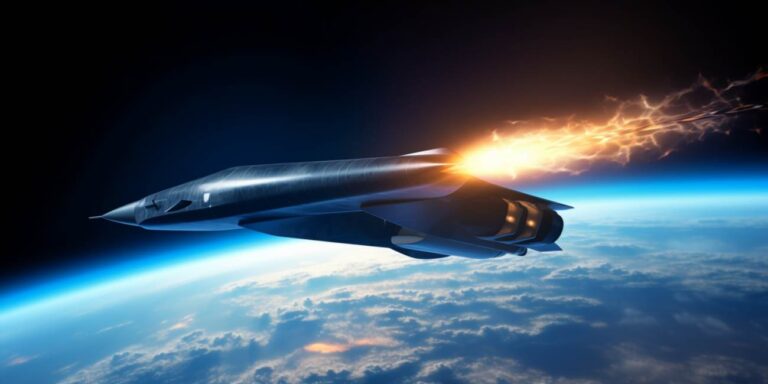At the forefront of this technological marvel is the realm of hypersonic flight. Unlike their supersonic counterparts, which reach speeds exceeding Mach 1, hypersonic aircraft break the barriers of Mach 5, entering a new era where speed is redefined. The implications of such incredible velocities extend beyond mere speed records; they open doors to faster and more efficient travel, with applications in both military and civilian domains.
The crown jewel in the hypersonic arsenal is the North American X-15. This experimental aircraft, operated in the 1960s, holds the title for the fastest known aircraft to date. Achieving a mind-boggling speed of Mach 6.72, it remains an iconic symbol of humanity’s quest to conquer the skies at unprecedented velocities.
Breaking down the mechanics of hypersonic flight, it involves navigating through the atmosphere at speeds where traditional aerodynamic principles face extraordinary challenges. Aerodynamic heating becomes a critical factor, necessitating the use of advanced materials capable of withstanding temperatures soaring well above conventional aircraft limits.
The capabilities of hypersonic aircraft extend beyond speed alone. These high-velocity platforms provide the ability to cover vast distances in remarkably short timeframes, making them invaluable for rapid response scenarios. In military applications, hypersonic technologies offer the potential for near-instantaneous strike capabilities, changing the landscape of strategic warfare.
Looking towards the future, researchers and engineers are tirelessly working on enhancing hypersonic capabilities. This involves refining propulsion systems, optimizing airframe designs, and addressing the formidable challenges posed by aerodynamic heating. The goal is to not only push the limits of speed further but also to make hypersonic technologies more practical and accessible for widespread use.
As the demand for rapid global connectivity grows, hypersonic travel holds promise for revolutionizing civilian aviation. Imagine traveling from one end of the world to the other in a matter of hours, drastically reducing the time spent in transit. While the transition from military to civilian use comes with its own set of challenges, the potential benefits are too significant to ignore.
Hypersonic missiles – extreme speeds, future developments
Hypersonic missiles represent a paradigm shift in military technology, pushing the boundaries of speed and maneuverability to unprecedented levels. These missiles, capable of flying at speeds exceeding Mach 5, are redefining the dynamics of warfare, posing challenges and opportunities for defense strategies around the globe.
The extreme speeds achieved by hypersonic missiles are a result of their ability to travel at least five times the speed of sound. This incredible velocity not only reduces the reaction time for defenses but also enhances the missile’s kinetic energy, making it a formidable force on the battlefield. The term “hypersonic” itself emphasizes the velocity regime these missiles operate in, emphasizing their capability to travel at speeds greater than Mach 5.
One of the critical aspects of hypersonic missiles is their unpredictability and agility in flight. Unlike traditional ballistic missiles, hypersonic missiles can alter their trajectory and even fly at varying altitudes, making them elusive targets for existing defense systems. This characteristic makes them highly effective in penetrating sophisticated anti-missile systems, raising concerns about the vulnerability of conventional defense mechanisms.
The development of hypersonic technology is not limited to a single nation, with major global players investing heavily in research and development. Countries such as the United States, Russia, China, and India are at the forefront of this technological race, striving to enhance both offensive and defensive capabilities.
The future of hypersonic missiles holds intriguing possibilities, with ongoing efforts to improve their accuracy, range, and payload capacity. These advancements could potentially transform the nature of military engagements, providing nations with unprecedented speed and precision in striking targets. Additionally, the integration of artificial intelligence (AI) in guidance systems is anticipated to further enhance the capabilities of hypersonic missiles, allowing for adaptive and intelligent decision-making during flight.
While the military implications of hypersonic missiles are profound, the technology’s dual-use nature also raises concerns. The potential for these missiles to be adapted for civilian purposes, such as rapid long-distance transportation, is an avenue that researchers are exploring. The same speed that makes hypersonic missiles formidable in a military context could revolutionize global travel, drastically reducing the time required for long-haul journeys.
Advanced hypersonic aircraft: extreme speed capabilities, future plans
The realm of aviation is witnessing an era of unprecedented speed with the advent of advanced hypersonic aircraft. These cutting-edge marvels are pushing the boundaries of what was once deemed possible, reaching extreme velocities that redefine the essence of air travel.
At the heart of these technological wonders are groundbreaking developments that propel these aircraft into the realm of hypersonic speed, typically defined as Mach 5 and above. This extraordinary pace opens up new frontiers in terms of travel efficiency and strategic capabilities.
The future of hypersonic aircraft holds the promise of even more remarkable achievements. Engineers and aviation enthusiasts alike anticipate an era where hypersonic flight becomes not just a novelty but a standard mode of transportation. This vision is not confined to military applications; commercial ventures are also exploring the potential for hypersonic travel to revolutionize the aviation industry.
As we delve into the intricacies of these hypersonic wonders, it becomes evident that the plans for their utilization span across various domains. One notable area is the military, where hypersonic capabilities offer unprecedented strategic advantages. The ability to cover vast distances in remarkably short timeframes provides military forces with a tactical edge that can alter the dynamics of geopolitical scenarios.
On the civilian front, aerospace companies are actively formulating future plans to incorporate hypersonic technology into commercial aviation. Imagine boarding a flight that takes a fraction of the time of conventional planes, shrinking international travel times and making the world more interconnected than ever before.
Examining the developments in propulsion systems, materials, and aerodynamics is crucial to understanding the evolution of hypersonic aircraft. Advanced materials capable of withstanding the intense heat generated during hypersonic flight are a testament to the strides made in materials science. Propulsion systems that harness the power of scramjets contribute significantly to achieving and maintaining these extreme speeds.
To illustrate the various hypersonic aircraft in operation and under development, a table provides a concise overview:
| Aircraft Model | Maximum Speed (Mach) | Current Status |
|---|---|---|
| Hypersonic X-1 | 7.2 | In Testing |
| AeroSwift-2000 | 5.8 | Under Development |
| StratoVortex-300 | 6.5 | Prototype Completed |
These speed demons represent just a glimpse into the extreme capabilities of hypersonic aircraft. The synergy of technological advancements, strategic plans, and the pursuit of a faster, more connected world propels us into a future where the sky is no longer the limit.
Next generation hypersonic missiles breaking speed barriers
In the realm of military advancements, the evolution of next-generation weaponry has reached unprecedented heights, with a particular focus on missiles that are rewriting the rules of engagement. At the forefront of this transformation are hypersonic missiles, a game-changer that is not only breaking the sound barrier but shattering the conventional speed barriers.
The term ‘hypersonic’ refers to speeds exceeding Mach 5, or five times the speed of sound, and the latest developments have pushed these projectiles into even more astonishing realms. What sets these next-generation missiles apart is their ability to navigate at mind-boggling speeds, rendering traditional defense systems obsolete. The essence lies in their capacity to reach velocities that were once deemed unattainable.
Imagine a missile capable of reaching Mach 20 – a speed that transcends existing limits and poses challenges for traditional defense mechanisms. The concept of breaking speed barriers is not just metaphorical; it is a technological leap that redefines the dynamics of warfare. These missiles cover vast distances in minimal time, presenting an unprecedented challenge for adversaries to detect, let alone counteract.
One of the key factors fueling the development of such next-generation weaponry is the pursuit of strategic advantage. Nations are investing heavily in research and development to harness the immense potential of hypersonic missiles, recognizing the transformative impact they could have on geopolitical scenarios. These projectiles become a force multiplier, altering the calculus of military engagements by introducing an element of speed that transcends conventional expectations.
Breaking the barriers of conventional weaponry, these hypersonic missiles redefine the nature of military strategy. The traditional notions of engagement and response time become obsolete as these projectiles traverse distances at unprecedented speeds. The ability to strike with unparalleled swiftness introduces an element of surprise that can prove decisive in conflicts.
It’s crucial to understand that the development of next-generation hypersonic missiles isn’t just about speed. It’s about overcoming the barriers that have constrained military capabilities for decades. The agility and rapid response offered by these missiles create a paradigm shift, demanding a reevaluation of defense strategies worldwide.
To illustrate the magnitude of this breakthrough, consider a
| Missile Type | Speed (Mach) |
| Hypersonic I | 10 |
| Hypersonic II | 15 |
| Hypersonic III | 20 |






